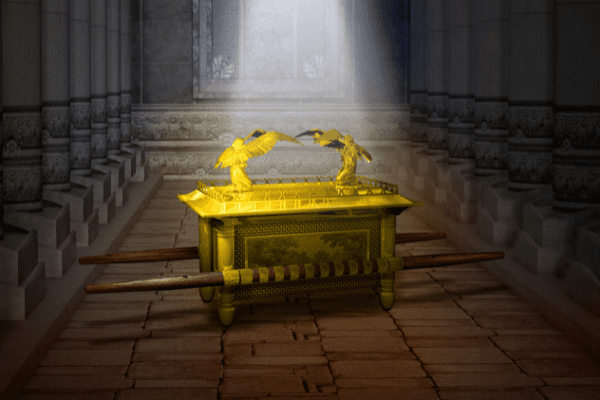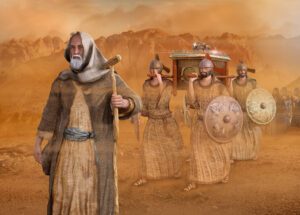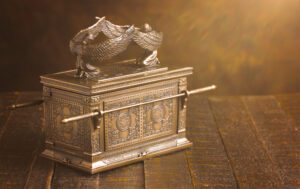After leaving Egypt and receiving the Torah at Sinai, the Jews were commanded to build a Tabernacle. At the epicenter of the Tabernacle was the Ark of the Covenant into which were placed the stone tablets.
Made of acacia (shittim) wood and measuring a half amah long, an amah and a half wide, and an amah and a half high (approximately 52×31×31 inches), the ark was covered in gold inside and out, and adorned with a crown or molding of gold called the zeir. Four rings of gold were attached to its four corners, two on each side. Through these rings, staves of shittim wood overlaid with gold were inserted for carrying the Ark, which the Torah commanded should never be removed. The staves were used by the Levites from the Kehath house to carry the ark, for it was forbidden to transport it by wagon.
It was covered with a golden lid (kapporet) which was ornamented with two golden cherubim, or winged figures, facing each other.
The Ark housed the tablets, engraved with the Ten Commandments, that Moses brought down from Mount Sinai, the broken pieces of the first set of tablets, and a Torah scroll. A pitcher of manna and Aaron’s miraculous staff were placed directly in front of it.
The Ark stood in the Holy of Holies, the innermost sanctum where only the Kohen Gadol (High Priest) would enter and only on Yom Kippur. In the First Temple, the ark stood on the even sh’tiyah, the foundation stone, but in the Second Temple there was no Ark of the Covenant in the Holy of Holies. King Hezekiah is the last biblical figure mentioned as having seen the Ark.
The Talmud (Yoma 53b) explains that when King Solomon built the Temple, he built an alcove deep within the Temple Mount for concealing the Ark should it become necessary, and it was in this place that King Josiah, foreseeing the destruction of the first Temple approximately 35 years before it happened, ordered that the Ark be hidden there (II Chronicles 35:3). The Talmud also presents an opposing opinion that states the ark was exiled to Babylon.
Jewish literature ascribes many miraculous attributes to the Ark. The Midrash (Yalkut Shimoni) said that when the Kohanim (priests) lifted it for transport, instead of them carrying the Ark, the Ark carried them. In addition, when the Children of Israel crossed the Jordan River into Israel, Joshua sent the Ark first, carried by the Kohanim. As they entered the water the river split, and they crossed on dry ground.
In the days of Samuel the prophet, the Children of Israel carried the Ark out to battle against the Philistines in the hopes that it would bring them victory. But the Philistines won the battle and captured the holy Ark, taking it to the pagan temple of Dagon in Ashdod. In the morning, the idol in the temple was destroyed and the Philistines became ill with hemorrhoids. The Philistines returned the Ark to Israel (I Samuel 4-5).
The Talmud (Yoma 21a) also explains that the Ark did not take up any physical space. The Holy of Holies was 10 cubits wide, and the Ark, which stood in the center, had a length of 2.5 cubits. Yet, when measuring from the sides of the Ark to the wall, there were still five cubits from the sides of the Ark to the walls.
The Ethiopian Orthodox Tewahedo Church claims to possess the Ark of the Covenant in Axum. According to the church, the Ark was brought to Ethiopia by Menelik I, the son of King Solomon, in the 10th century BCE. The Ark is currently kept under guard in a treasury near the Church of Our Lady Mary of Zion. Only one person, appointed as the Guardian, may enter the building and look at the Ark. The Guardian, as his title implies, must protect the Ark and is prohibited from leaving the grounds.









